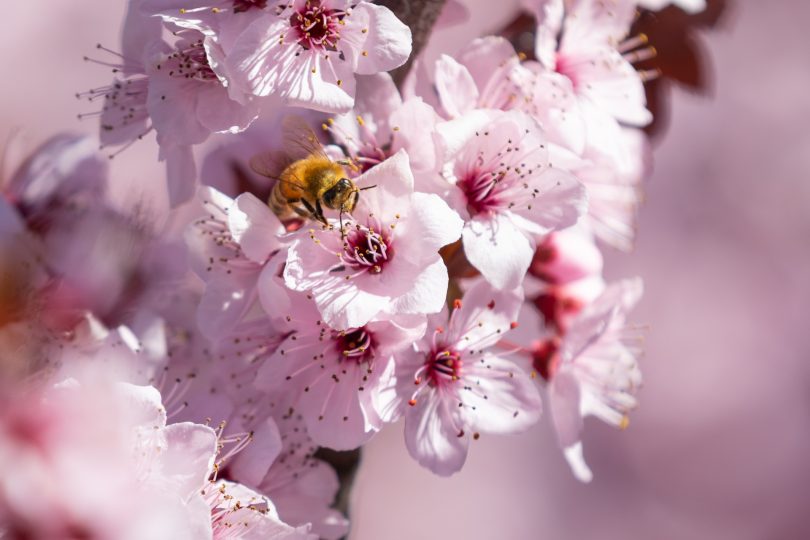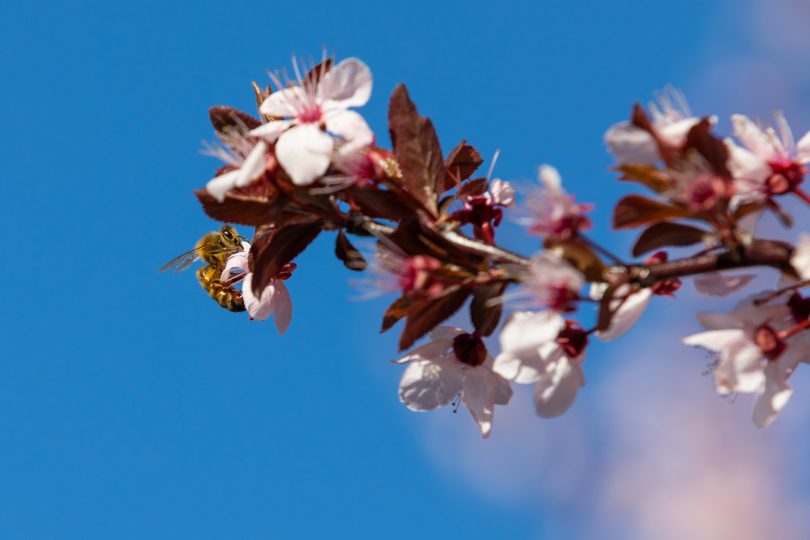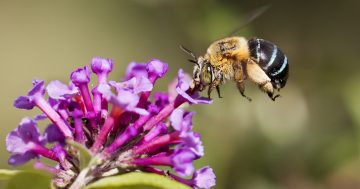
A honey-bee swarm can be made up of between 5,000 and 10,000 bees. Photo: Cormac Farrell.
Massive swarms of honey bees travel around the ACT in search of a new home at this time of year, and local beekeepers are on call to ensure they don’t choose the wrong one.
After all, a hive in the wall cavity of your house is a major and potentially costly problem. Bees can also stake a claim in tree hollows, pushing birds and animals out of an otherwise ideal nesting place.
Beekeeper for Canberra Region Beekeepers Cormac Farrell says it’s common to see around 100 to 200 swarms every year in Canberra.
“There are approximately 2,000 species of bee in the world, and Canberra is home to about 200. The one behind the swarms is the exotic honey bee,” he says.
This species only lives in large colonies and can’t function on its own, so when a colony outgrows its existing home, half are sent packing with the old queen while the rest stay behind and raise a new queen.
And with so many flowers to go around at the moment, honey bees are adopting a sort of ‘divide and conquer’ strategy.
“Right now, it’s spring. There is lots of nectar to go around and they’re looking at that and going, ‘Well, now’s a good time – let’s have a go’,” Cormac says.

With all the flowers out now, bees are hard at work. Photo: Thomas Lucraft.
The average swarm is made up of between 5,000 and 10,000 bees. And although that might sound like quite a crowd, a full-size, full-production colony is typically 20,000 to 30,000 bees.
They leave with the old queen and cluster in random places while they figure out where to live, which Cormac compares to moving out of home and into a share house while trying to save up for your own place.
He says it’s important that Canberrans know to call a beekeeper if they spot a swarm in this transitional phase.
“It’s relatively straightforward. We knock the bees into a box and give them somewhere to live. They were looking for one anyway and they stay and don’t wreak havoc elsewhere.
“If there is a beehive in someone’s wall, you have to tear the wall apart to get them out. Or if they’ve moved into a tree hollow, the native animals can no longer use it. Both are bad outcomes we want to avoid if we can.”
Cormac and the fellow beekeepers also happen to score a free colony out of it.
“One of the simplest ways to get started as a beekeeper is for someone to catch a swarm for you, and you’re in business,” he says.

Bee on blossom flower at the start of Spring. Photo: Michelle Kroll.
In addition to fetching swarms on call, beekeepers also lay out ‘bait hives’ to lure the wandering bees in.
“Essentially, we don’t have to do anything then. We just sit back and watch it happen. In general, that’s how it works in beekeeping. They do all the work and we take all the glory.”
Canberra Region Beekeepers comprises about 500 members, many of whom are in it for the honey. Another benefit to swarm control is keeping the honey-producing bees in managed hives.
“The ACT Government has been pretty fantastic in optimising bee colonisation by having a wide variety of street trees and gardens. We’re a city of gardeners, which makes a good place for producing top-quality honey.”
Cormac’s other position is that of ‘Head Beekeeper for the Australian Parliament’. A role not without its dangers – he is stung around six times a year. Cormac’s position stems from what was thought to have been an April Fool’s Day prank in the 1970s.
The story goes that William Yates, a Liberal backbencher at the time, asked Speaker Billy Snedden if he could bring bees to the grounds. The Speaker, seeing that the calendar read 1 April, agreed.
William then proceeded to set the hives up in the grounds a few days later, much to the shock of the rest of the politicians.
There they have stayed and today consist of six hives, including four honey-bee hives.
The full list of local beekeepers is available on the Canberra Region Beekeepers website, along with contact information and collection areas.
Original Article published by James Coleman on The RiotACT.





